This post may contain affiliate links. This means that if you click and make a purchase, I receive a small commission at no additional cost to you. I only recommend products I use and love, or that I would recommend to my mom or best friend. Please see the disclosure statement for additional information.
Your electricity just went out.
Your toilet is overflowing.
You smell natural gas in your home.
Would you know what to do?
If your first response is, “Oh, that’s my husband’s/boyfriend’s/random stranger’s job…” uh-uh.
No, lovely, it’s your job. If you’re ever home by yourself for any length of time, you need to know how to react when your utilities go awry.
And even when you’re not home by yourself, strong women still know how to get stuff done.
In the interest of helping you to be a strong woman and take great care of your home, I’m going to give you the rundown on finding and using your utility shutoffs.
Let’s get to it!
Electrical
So your power’s out. Where do you start? With your breaker box!
Locating your breaker box
Breaker boxes are typically in a cool, dry area with adequate shelter from the elements. In the midwest, where I live, the breaker box is typically located in the basement. If you live in an apartment or your home doesn’t have a basement, check in your garage, or an interior hallway. Here’s the breaker box in my house, circa 1976 (No, really):
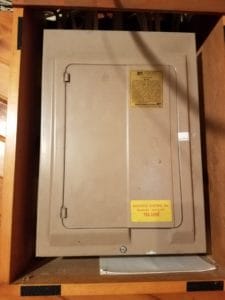
Understanding your breakers
So what do circuit breakers do, exactly?
Well, they break the circuit. They’re actually a safety feature. If there is too much amperage going through an electrical circuit, the breaker is tripped, causing an interruption in the flow of electricity.
Each breaker controls the power to a specific group of fixtures in your home. Think ordinary outlets, overhead lighting and fans, and appliances.
The circuit breakers should be labeled to show which areas of the home they correspond to. Labels are usually either next to each breaker, or on the inside of the breaker box door.
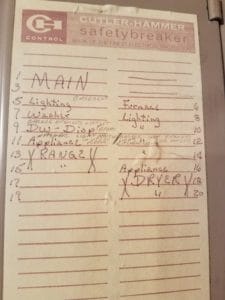
There is one mack-daddy breaker which is typically labeled “main.” It controls the flow of electricity into the entire breaker box. If the main is off, everybody’s off.
You can see in the pictures above and below that the main circuit breaker is at the top left of the breaker box.
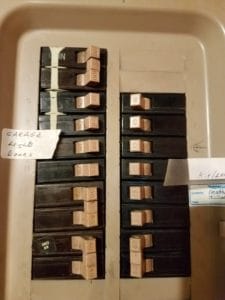
The Spruce has a great article on main circuit breakers. Check it out here (I know you just can’t wait!).
Flip it and reverse it
How do you reset a tripped breaker?
It’s easy, but requires a little caution.
In my breaker box, in means on. In other words, all of the circuit breakers pointed in toward the center are active (I.e., they haven’t been tripped).
The picture on the left shows all breakers on. In the picture on the right, breaker 13-15 has been tripped.
[one_half_first]

[/one_half_first]
[one_half_last]
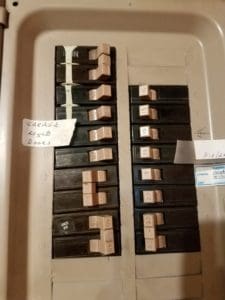
[/one_half_last]
This is a double-pole breaker, which basically means it can handle the extra power needed to run large appliances and HVAC systems. This breaker controls my stove. See how that little list on the inside of the door came in handy?
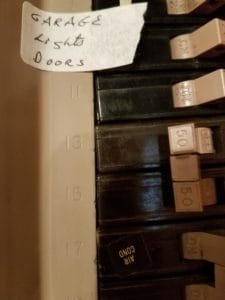
So anyway, back to resetting the breaker. Stand back and to the side to avoid any potential sparks. Slowly push the breaker in the opposite direction.
Bingo.
Done.
If the same breaker trips again, you may need to call in a professional, because something probably isn’t right.
Water
Similar to electricity, water also has a main shutoff, as well as shutoffs for fixtures. Unlike electricity, however, fixture shutoffs aren’t in a centralized location. Rather, they’re located on the water pipe which feeds each fixture.
Locating your main water line
Your main water line feeds water into your home. It’s typically located in in the basement. If you don’t have a basement, try your garage, or a utility closet. the water main is usually located fairly close to the water heater. It’s usually a handle mounted on a vertical pipe. Mine helpfully indicates which way is on, and which way is off:
[one_half_first]
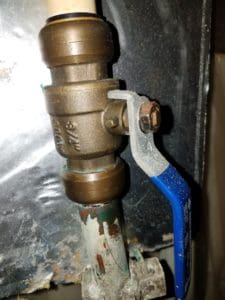
[/one_half_first]
[one_half_last]
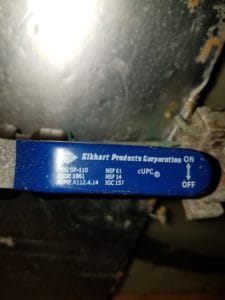
[/one_half_last]
Locate fixture shutoffs
Water lines to sinks and toilets typically have their own shutoff valve. They’re usually little football-shaped knobs.
Typically, you’ll find them under or behind a sink (Notice the separate knobs for hot and cold water in the picture on the left):
[one_half_first]
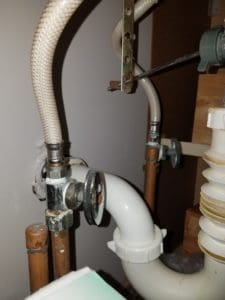
[/one_half_first]
[one_half_last]
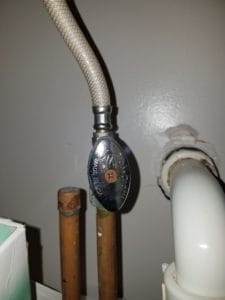
[/one_half_last]
Or beside or under a toilet:
[one_half_first]
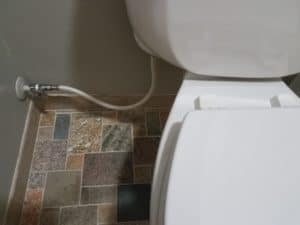
[/one_half_first]
[one_half_last]
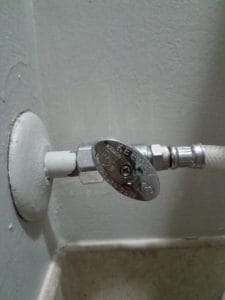
[/one_half_last]
Turn water supply on or off
If your main is leaking, or you have a leak but can’t determine the exact source (Think water pouring down from the ceiling), you can switch off the main line just to be safe.
If you know which fixture is leaking, such as a sink or toilet, you can turn off the water supply to just that fixture.
For these, lefty-loosey, righty-tighty generally holds true. Turning to the left means water is able to flow to the fixture, and turning to the right means water to the fixture is off.
I had an incident a few months ago where knowledge of my water shutoffs came in very handy.
Hearing a drip, drip, drip in my kitchen had me worried. I went in to investigate, and oh my gosh. It was raining on my breakfast bar.
I ran upstairs to find that the water line on the toilet directly above the kitchen was leaking, so I shut the water off right then and there. I spent the next 2 hours blow-drying my kitchen ceiling, but there was no permanent damage. And it could have been much worse!
Natural Gas
Like water, natural gas has a main shutoff and individual fixture shutoffs.
It’s important to note that turning off your main gas line manually could have repercussions. It’s best to check with your gas company regarding how and when to shut off your gas main yourself. That being said, the manual shutoff is located on your gas meter, which is usually outside your home (Often tastefully hidden among attractive foliage):
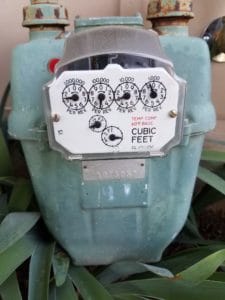
If you suspect a gas leak, the best thing to do is to leave your home immediately and contact your gas company. A hissing or whistling sound, or the presence of a Sulphur-like odor (Think rotten eggs) can indicate a gas leak. A high concentration of gas could potentially ignite, causing a fire or explosion.
If you know for sure which appliance is leaking gas, you may be able to turn off its gas supply. Then, contact a professional for help.
Take a look at your gas-powered appliances (Possibly water heater, furnace, and maybe even your dryer). Most have specific instructions on how to turn off the gas supply. Read the instructions carefully, and don’t try to tango with re-lighting the pilot light unless you know how to do it (We won’t be covering that today!).
As an example, here’s a look at the instructions and gas control on my water heater:
[one_half_first]
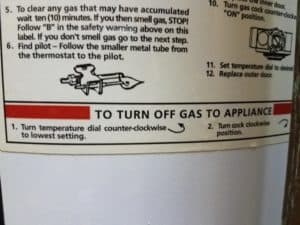
[/one_half_first]
[one_half_last]
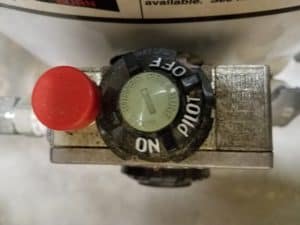
[/one_half_last]
Conclusion
Utility shutoffs provide an important safety feature when something goes wrong. Regardless of whether you live alone, it’s important to understand what they do and how to operate them. That way, if the power goes out, you have a water leak, or a suspected gas leak (Hopefully not all 3 at once!), you’ll know exactly how to react. Because strong women know how to get stuff done.
Have you ever flipped a breaker or turned off a water line? Who taught you to do it? Let me know in the comments below!

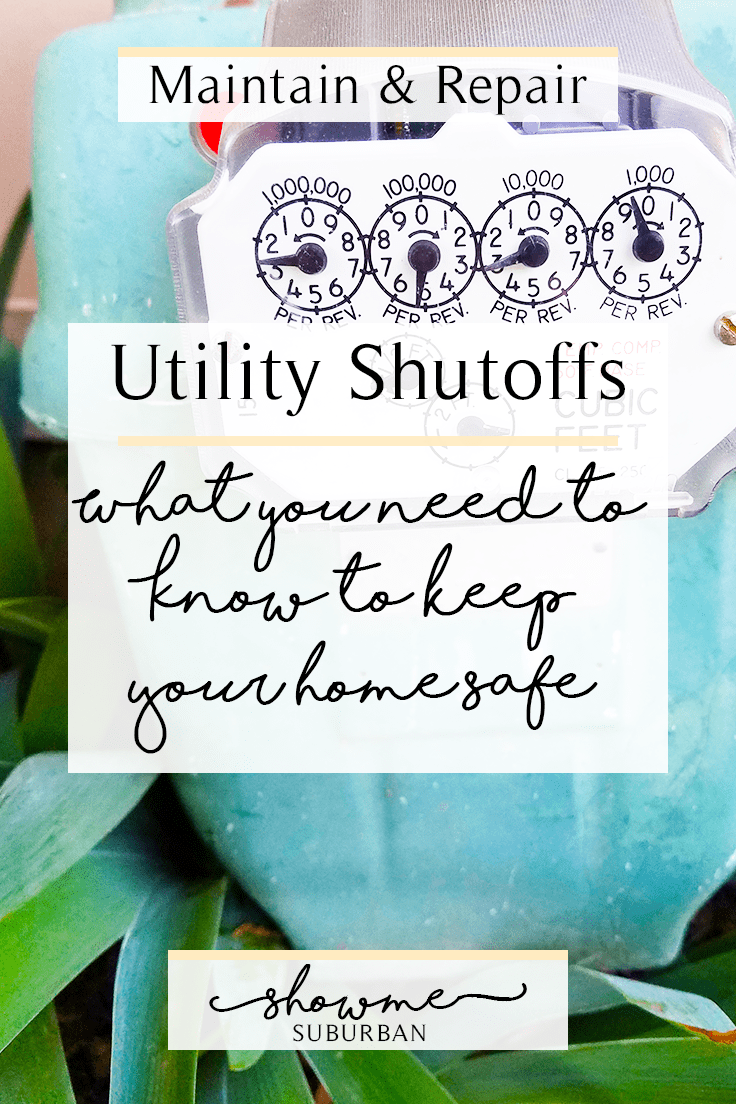
My dad taught me how to do these things. Since I moved a lot as an adult, it was important to me to find this stuff each time I moved to a new house.